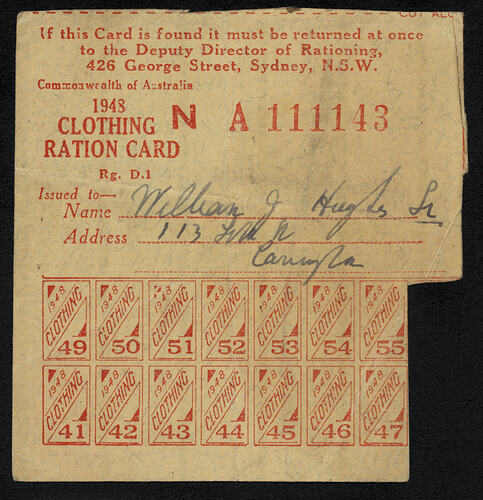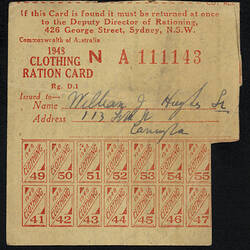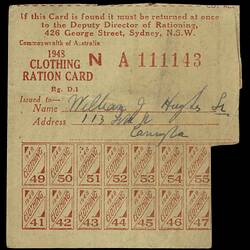Summary
Clothing ration card printed in red on cream paper, dated 1948. It was made by T.H. Tennant, Government Printer.
Shortages of foodstuffs, clothing and other products were part of life on the homefront during World War II. The first controls over the production and distribution of products were introduced in 1940, partly due to disruption of shipping. In 1942, after Japan entered the War, comprehensive rationing was introduced to manage shortages and control civilian consumption. The first product to be rationed was clothing, gazetted on 12 June 1942. Each adult was allowed 112 clothing coupons per year. Tea rationing was introduced the following month, followed by sugar, butter and then meat. After the War, rationing was gradually phased out. Clothing rationing was abolished on 24 June 1948. The last rationed product was tea, which ended in July 1950.
Physical Description
Cream card printed in red ink for clothing rationing. Hand-written text in black ink. Originally had 16 coupons; two now cut off.
More Information
-
Collecting Areas
Public Life & Institutions, Working Life & Trades, Home & Community
-
Acquisition Information
Donation from Mr Andrew Reeves, 04 Jul 1992
-
Organisation Named
Antarctic Division, Department of Science, Commonwealth of Australia
-
Person Named
William J. Hughes Senior, 113 Lott Street, Carrington, New South Wales, Australia, 1948
-
Inscriptions
Front: If this Card is found it must be returned at once/to the Deputy Director of Rationing,/426 George Street, Sydney, N.S.W./Commonwealth of Australia/1948/CLOTHING/NA 111143/RATION CARD/Rg. D.1/Issued to /Name William J. Hughes Sr/Address 113 Lott St./Carrington. [14 coupons]
-
Classification
-
Category
-
Discipline
-
Type of item
-
Overall Dimensions
8 cm (Width), 8.3 cm (Height)
-
Maximum dimensions
78 mm (Width), 83 mm (Height)
Measurement From Conservation. width 69 - 78mm [irreg.]
-
References
'Rationing of food and clothing during the Second World War', National War Memorial, [Link 1] accessed 30/1/2009 Departmental history of rationing of clothing and food, 1942-1950 (Melbourne: Commonwealth Rationing Commission, 1950) S.J. Butlin and C.B. Schedvin, War economy, 1942-1945, Australia in the War of 1939-45, vol. IV, (Canberra: Australian War Memorial, 1977): pp. 286-309
[Book] Darian-Smith, Kate. 1990. On the home front: Melbourne in wartime 1939-1945.
-
Keywords
Home Fronts, Merchant Seamen, Ration Coupons, Rationing, Wars & Conflicts, World War II, 1939-1945



